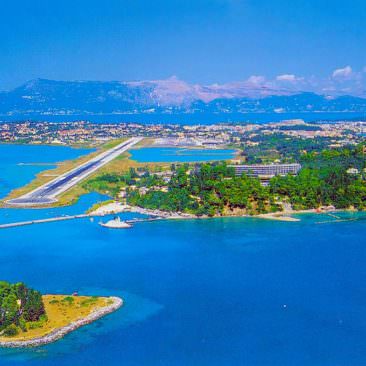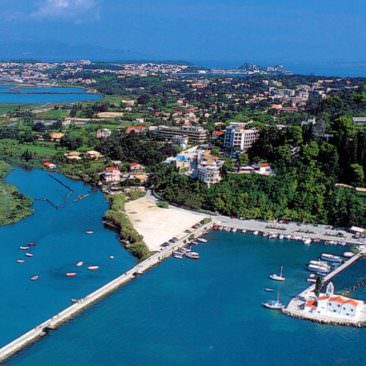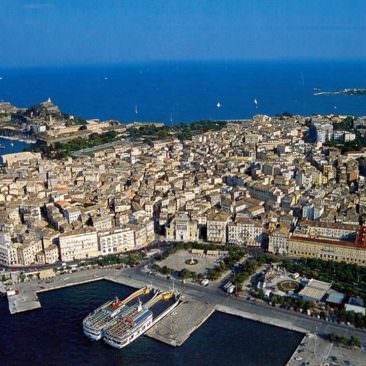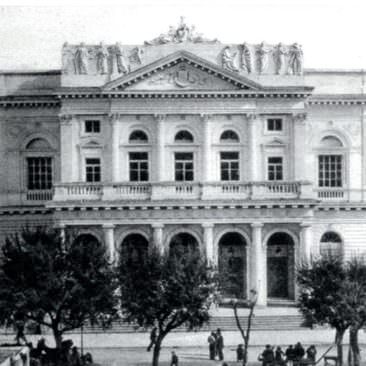About Corfu island

Corfu map
Corfu (Kerkyra) is one of the most important and beautiful islands in Greece, perhaps the greenest island with dense vegetation and a well developed road network.
Speaking about tourist development is one of the country`s cornerstones in tourism industry.
It is an island with a long history, and has been notable in Greek culture and tradition for over 3000 years.
It has been inhabited since the paleolithic era and later by the Phaeacians as mentioned in the Odyssey.
Homer refers to it as Scheria, but the island also had the name Drepanon(sickle) at a time because it is shaped like a sickle.
For most visitors the entrance to the island is the newly renovated international airport Ioannis Capodistrias, although the ferries from Italian ports are also extremely busy.
The flight from most European airports takes between two to three and a half hours.
Where is Corfu?
Located in the north Ionian sea at the northwestern edge of Greece.
It seems to be far away from Athens, and maybe nearer to Italy, but what it offers are well worth the visit.
The flight from Athens takes 45 minutes.
In recent years Corfu has become one of the favourite destinations for Greek tourists too, especially during the Easter holiday which has gained nationwide attention with it’s unique traditions, but also in August when Greek and Italian visitors mingle with those from further north.
Since the Egnatia highway has been built it is easily accessible from residents of northern Greece.
From the port of Igoumenitsa on the mainland there is a very frequent modern ferry service, some crossing to Corfu in just over an hour, ferries also land in the southern harbour of Lefkimi.
The first view of Corfu from the sea is the medieval town of Corfu, the only Greek kastropolis (city surrounded by fortresses) maintaining intact its Venetian style with narrow streets (alleys) and tall buildings, a standard Italian rather than Greek city that has barely changed despite the intense development.
The city offers numerous attractions and monuments that need days to explore and admire.
Where the name came from?
During the Middle Ages the island and the town took the name Corypho which means peaks, (Coryphai in Greek), due to the two peaks in the peninsula of the old fortress, or the two peaks of it`s highest mountain Pantokrator.
It is obvious that from this name Corypho the current international name of Corfu was derived.
The name Kerkyra derived from the nymph Corkyra, the daughter of the river god Asopos.
Corkyra was kidnapped by the god of the sea Poseidon who brought her here, then Phaiax was born as the result of their union, Phaiax was the founder of Phaeacians, the fisrt known residents of Corfu.
The word Corkyra transformed to Kerkyra in Doric dialect and this is the modern Greek name for the island.
Corfu Town has also the name Kastropolis which means a city inside castles, because in the past it was one of the few cities in the world surrounded by the walls of both the old and new fortresses.
Location and Population of Corfu
Corfu is located in the northern Ionian Sea, opposite the coast of the Greek mainland and southern Albania, it is the westmost part of Greece.
Northwest of Corfu there are three small islands, named Othoni Mathraki and Erikoussa respectively, known as the Diapontian islands, and to the south are the islands of Paxos and antiPaxos .
All together they form the Prefecture of Corfu.
It is a medium sized island with an area of 588 square km, according to the census of 2011 the population is 101.113 inhabitants, although including temporary and semi-permanent residents the total approaches 150,000 people, while the town of Kerkyra alone has 30,000 inhabitants.
The length of the island from north to south is not more than 61 km and the greatest width is 27 km, the coast have a total length of 217 km.
The northern part of the island is mostly mountainous and is dominated in the north east by Mount Pantokrator (the ancient Istone mountain).
Its highest peak is the easterly one of Pantokrator (914 metres) and a little lower is Stravoskiadi peak a few miles to the west at 849 metres.
The mountain continues westward and dominates the northwest part of the island whose highest peak is Troumpeta at 600 metres.
In the middle of the island there is another mountainous area above the villages of Stavros and Agioi Deka, The highest peak here is above Agioi Deka where the crater of an extinct volcano at an attitute of 600 metres can be visited and where there is an aviation radar station.
The southern part of Corfu is mostly flat with a few hills above the villages of Chlomos and Saint Mattheos.
This island, comparing size and population density, is the third most populous place in Greece after Athens and Thessaloniki.
The climate is generally mild with hot and dry summers and very mild winters, in Corfu it rarely snows, except on the top of Mount Pantokrator.
Most Corfiots will see snow on their land no more than 2-3 times during their lifetime.
From 2011 after the administrative reform called “Callikrates” the island became one municipality, the municipality of Corfu which originated from the merger of the 12 former municipalities, the municipalities of Corfiots, Achilleion, Thinalion, Lefkimi, Korrision, Paleokastriton, Melitieon, Saint George, Esperion, Feakon, Kassopaion and Parelion.
There is also another municipality in Paxos with the town hall in the capital Gaius, and three more communities in the Diapontian islands in the north.
Corfu Culture
Influences by Corfu`s conquerors
Culturally Corfu is very different from the rest of Greece, as whilst they had to suffer the Turkish occupation Corfu was a vital part of the powerful maritime state of Venice.
This was the era that shaped and fundamentally influenced the cultural character of the island and its residents.
On one side the authoritarian attitude of the feudal ruling class of nobles created continual opposition and popular movements on the part of the poor people, whilst on the other side the development of arts and culture in general differentiate the landscape in complete contrast to the rest of Greece as Corfu was influenced by the west, while the rest of the country was forced to look east.
The Venetian period was followed by the French dependencies, first the democratic French and later the imperial rule of Napoleon, followed briefly by the Russians and finally the English protectorate period until 1864, when together with the rest of the Ionian Islands Corfu was unified with Greece.
Buildings and monuments
All these influences have left their marks, so on the island there are now buildings and monuments from the ancient Greek and Roman times onwards, especially in the old town which is actually an extremely beautiful miniature of Venice without the canals.
Corfu has many museums, monuments and cultural centres, The first modern Greek university was established here, and by 1850 there was a power plant on Corfu which moved to Piraeus after the union with Greece.
Here you can visit the old and the new fortresses and see the Esplanade square, perhaps the biggest in Europe,
The Liston, a meeting place for the nobles of the past and now a social hub for all Corfiots and the Palace of Saint Michael and Saint George (known as the old palace) which today houses many museums and exhibitions, are both located around this square.
The Ionian Academy the first university of Greece founded in 1824 here, the Ionian parliament building is nearby, as is the town hall which was built in 1663 initially as the Hall of Nobles (Loggia dei Nobili) and later became the Theatre of San Giacomo.
Just outside the modern town are the ancient remains of Paleopolis, the ancient city of Corfu on the peninsula of Kanoni near to the summer palace of Mon Repos.
There are numerous other places of cultural interest, museums and monuments outside Corfu town, such as the Byzantine fortress north of Paleokastritsa called Aggelokastro and the Venetian shipyard at Gouvia.
The Achilleion palace is in the village of Gastouri 3 kilometers north of Benitses, and was built by the Empress of Austro-Hungary Elizabeth, also known as Sissy.
The palace was named in honor to the legendary hero Achilles and reflects her love for classical Greece.
Kaiser’s bridge on the beach of Achilleion was built by the German Kaiser Wilhelm the second, the owner of the Achilleion after Elizabeth’s death.
The sea museum in Benitses, the museum of olives at the village of Kynopiastes, old houses of all sizes, small museums, fascinating collections and ancient remains can be seen in many villages.
Kerkyra has retained its medieval style as the town had the fortune never to have ever been hit by powerful earthquakes as sadly happened in Kefalonia and Zakynthos, because although it is located in the seismic geology of the Ionian arc, it sits in a more stable part of the earth’s crust which cannot produce earthquakes capable to destroy the unique architecture of the city of Corfu.
Corfu contribution to the formation of the modern Greek state
There is a huge musical tradition in the island and Corfu town has three main philarmonik societies, the Old Philharmonic, the Philharmonic of Mantzaros and Philarmonic of Kapodistrias, whose orchestras regularly give excellent concerts.
In many villages there are also bands, and on certain days they all play in Corfu Town, to loud cheers from their supporters.
Corfiot intellectuals
The immense contribution of Corfiot intellectuals to the formation of the modern Greek state is well known, and the island has produced world renowned personalities accomplished in many different spheres,
Without mentioning the younger generations, the famous personalities which were born or lived here include Ioannis Kapodistrias the first governor of Greece, Nikolaos Mantzaros the composer of Greek national anthem, Dionysios Solomos our national poet who lived here for the last 30 years of his life, Spyros Samaras the composer of the Olympic anthem, the famous Italian composer Antonio Vivaldi lived much time of his life on the island, as did poets like Gerasimos Markoras, Lorenzos Mavilis, Andreas Kalvos, and Iakovos Polylas.
A former Greek prime minister was George Theotokis, whilst his relative Nikolaos Theotokis became the archbishop of Russia.
The important Ecumenical patriarch Athenagoras and St Filomena were born here too.
The unforgettable actors Vasilis Avlonitis and Nikos Kourkoulos originate from Corfu, also Albert Cohen and the singers Vicky Leandros and Nana Mouskouri were born here…
There are hundreds of others who can not fit onto this page, even Giacomo Casanova spent much of his life in Corfu.
Corfu has given and still gives a lot in Greece, both culturally and economically with the huge tourist growth, but has not necessarily taken back all that it definitely deserves …
Corfu environment and biodiversity
Environmentally Corfu is a whole continent in miniature, It has an immensely varied landscape, from lush forests and green mountains to deserted sandy beaches reminiscent of the Sahara, and they all contain unique ecosystems rich in biodiversity.
There are hundreds of rare species of birds, wildlife, insects and all kinds of plants and trees that can be found in the Mediterranean and further away too.
The dominant tree is the olive tree, seconded by citrus fruit trees, whilst the cypress spires remind us of Corfu’s Italian inheritance.
Corfu has the highest rainfall and the richest soil in Greece and could be self-sufficient in all areas of production, but the development of tourism and other factors have led the population to other ways of making a living.
Definitely Corfu is an island well worth visiting, To explore it and understand two or three weeks are not enough, it is like a great work of art that reveals itself more and more the longer it is looked at.










